Nasopharyngeal / oropharyngeal swab specimen collection (COVID 19)
Требуемые условия завершения
Authors: Rednenko V.V., Rednenko L.I.
Editor: Rednenko V.V.
Equipment for the practical skill:
- Chire
- Table (manipulative table)
- Testing kit
- 2 sterile synthetic fiber (artificial cotton) swabs with plastic or wire shafts. (Do not use calcium alginate swabs or swabs with wooden shafts, as they may contain substances that inactivate some viruses and may inhibit molecular tests).
- spatula
- test tube with stopper
- label for test tube or marker
- container for transporting samples of biological material
- request form
- PPE
- skin anticeptic
- waste containers
Clinical situation:
- You need to take samples from the patient's nasopharynx and oropharynx for a covid test
Order of the skill performance:
Preparatory stage:
- put on PPE
- inform the patient about a procedure, get verbal consent to giving it
- check the request form
- place all items of testin kit on the table
- 2 swab
- test tube
- spatula
- prepare test tubes
- put a test tube rack on the manipulative table
- take a test tube and mark it with marker or stick a label on it
- remove a stopper from the test tube
- place the stopper on the manipulative table
- put the test tube in the test tube rack
- open the package with the swabs and the spatula
Maine stage:
- Ask the patient to sit in the relaxed and comfortable position during the sample collection process
- Tilt the patient's head back slightly and support it with your non-dominant hand. If necessery, lean the patient's head against a wall to minimize jerky movements
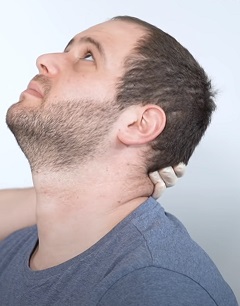
- Stand slightly offset from the patient to avoid the risk of contamination in case of sudden cough or sneeze
- Advise the patient of potential discomfort during sample collection, and let the patient know that they are welcomed to close their eyes
- Hold the swab like a pen between the thumb, index and meedle fingers. Maintain a loose grip that allows the swab to accommodate any resistance encountered durin samle collection to reduce the risk of injury
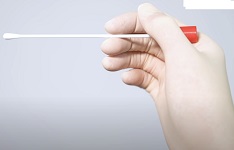
- Avoid using the following hand position during sample collection
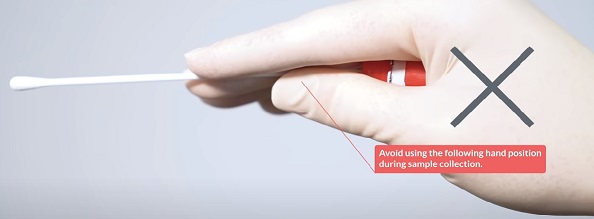
- Nasopharyngeal swab specimen collection
- Start by inserting the swab horizontally into the left or right nostril
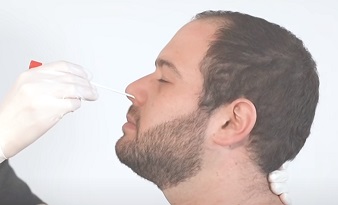
-
- Carefully advance the swabe while maintaining a course that is close to both the septum and the floor of the nose, parallel to the palate
- Do not advance the swab upward, but instead straight back until resistance is felt as the swab reaches the posterior nasopharynx. When collecting samples from an adult patient, this corresponds to a travel distance of approximately 5-6 cm. The swab should reach a depth equal to half the distance between the nostrils and the outer opening of the ear

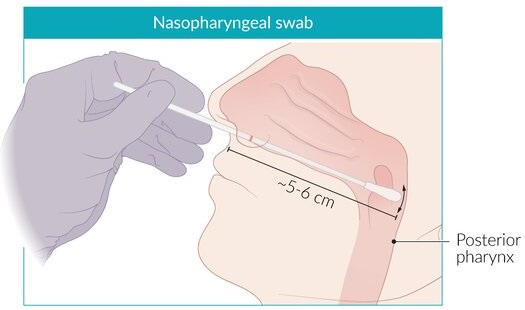
-
- Leave the swab at this depth for a few seconds while gently wiping the wall by twisting the swab shaft
- Slowly and gently remove the swab
- Collect nasopharyngeal swab specimen from other side using the same swab
- Immediately insert the swab into the sample collection tube, which may contain 2-3 ml of viral transport media.
- Once the tip is near the bottom, break the swab handle at the swab breakpoint by bending back and forth or cut it off with sterile scissors.
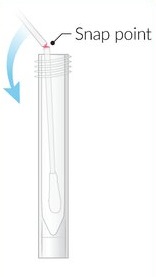
-
- The swab should fit in the tube comfortably so that the cap can be screwed on tightly to prevent leakage and contamination.
![]()
- Oropharyngeal swab specimen collection
- Inform the patient that the procedure will feel uncomfortable for a short time and may trigger a gag reflex
- Ask the patient to open their mouth wide, protrude their tongue forward, and say "Ah"
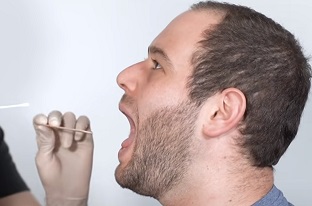
-
- Take a swab with your dominant hand and spatula (tongue depressor) with your non-dominant hand
- Depress the patient's tongue using the tongue depressor
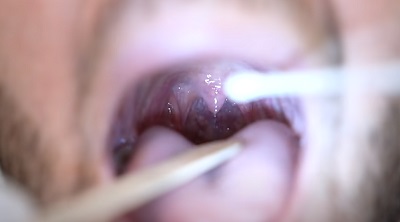
-
- Gently insert the swab ito the oral cavity without touchin the lips, teeth, tongue, hard palate, or soft palate. These surfaces shold be avoided as they are often colonized by a wide range of microbes
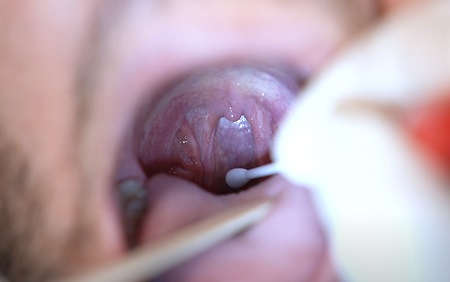
-
- Collect the sample from the back wall of the throat. Twist the swab shaft gently but thoroughly, sampling the oropharyngeal wall
- Slowly and gently remove the swab
- Immediately insert the swab into the sample collection tube (the same where nasopharyngeal samples are placed)
- Close the tube
Final stage:
- disinfect disinfect surfaces;
- take off the gloves, place it in the container “Disinfection of dressings, PPE” (see Removal contaminated gloves);
- place the test tube in the container for transportation of biological material samples
- wash your hands (see Hygienic hand washing)
Последнее изменение: понедельник, 12 сентября 2022, 10:48